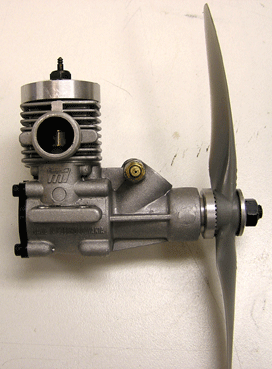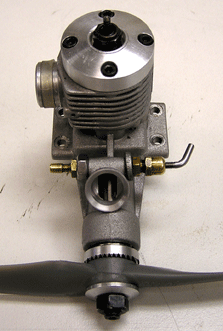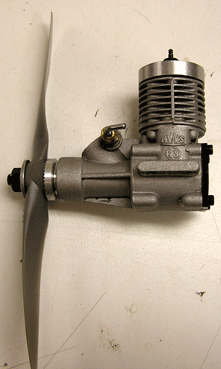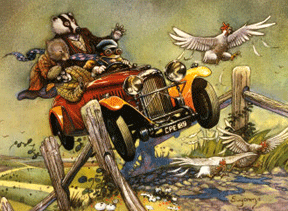



Three views of the MVVS engine discussed below as a possible 80mph combat engine. Broadway Bod Busters photos.
Yes folks it's true,
To quote an old friend of the Broadway Bod Busters, "You
can't always get what you want, but if you try sometime, you just might
find" you get blown up engine parts!
(thank you Mick Jagger)
And so it was for me trying to do the easy part of the combat clinic. The initial idea was easy, it just popped out like so many ideas do. "We'll have a seminar!" I shout, "A clinic!"
The Rein Man chimes in and sez, "We can let them fly our stuff!" "Brilliant" I cry!
"I'll write up our stuff on the R&B, you do an engine" "Right-O" I say, itsapieceofcake!
We toast our combined brilliance with yet another beer and set out planning on who what when and where of the clinic.
"Do you suppose they'll want to use F2D motors or cheap and available ones from the mail order places" I wonder out loud. Gotta be the cheap-o available ones.you can do it man, you're the engine guy!" Right I say and move on to the next thing forgetting all about the motor.
Monday arrived too soon and part of it was my research into finding a
.15 that would be suitable to pull an F2D on 60 foot .015 lines at 80+ mph.
 Flying combat and in particular F2D can put you into a vacuum of sorts.
It didn't occur to me that I had been in one for years due to being spoiled
by superbly well engineered and manufactured engines by the likes of Henry
Nelson, Alex Kalmykov, Profi, Fora and others. I fought mightily to get
my head out of the vacuum and find what seemed to me to be a minor request,
"just need an engine to run around 25,000 rpm, not blow up, start easily
and not weigh a ton." Oh yes, it has to cost around $50.00.
Flying combat and in particular F2D can put you into a vacuum of sorts.
It didn't occur to me that I had been in one for years due to being spoiled
by superbly well engineered and manufactured engines by the likes of Henry
Nelson, Alex Kalmykov, Profi, Fora and others. I fought mightily to get
my head out of the vacuum and find what seemed to me to be a minor request,
"just need an engine to run around 25,000 rpm, not blow up, start easily
and not weigh a ton." Oh yes, it has to cost around $50.00.
My first stop was Norvel, (out of business), then CS. They showed a .15 for about the right price, another was the Magnum XLS. This too had the right price and the stunt guys are using the .36 so maybe they are well made. O.S costs too much so that was out and there were a few others that were either too expensive or slightly too large. (.18 ci) Finally I did some research on the Magnum and liked what I read, lots of power and well made. I like engines and this was getting more fun, I eagerly awaited the arrival of engine #1.
The CS arrived first and it looked a bit puny, the liner was steel, the
case very small and it was stuck with dried brown stuff. "looks
sorta funny" the Rein Man said. "Yeah" I mumble and took
off the back plate. Inside it was covered in the same brown stuff that looked
a bit like rust.  I filled it with denatured
alcohol and cleaned it out. Once you could see, it was clear that this was
no runner. I oiled it and packed it up returning it for a refund. Next came
the Magnum, it looked clean and felt like a decent sort of motor. Nice workmanship,
snappy compression and a pretty blue cylinder head. (We like color!) Charging
to the test bench we fired it up, broke it in and put a tach on it. 23,500
on an APC 7 x 3, not bad for starters. The configuration was an R/C engine
so we put a Nelson NVA into the new arrival, mounted it on a waiting R&B
and flew it the following day.
I filled it with denatured
alcohol and cleaned it out. Once you could see, it was clear that this was
no runner. I oiled it and packed it up returning it for a refund. Next came
the Magnum, it looked clean and felt like a decent sort of motor. Nice workmanship,
snappy compression and a pretty blue cylinder head. (We like color!) Charging
to the test bench we fired it up, broke it in and put a tach on it. 23,500
on an APC 7 x 3, not bad for starters. The configuration was an R/C engine
so we put a Nelson NVA into the new arrival, mounted it on a waiting R&B
and flew it the following day.
We tried many props, plugs, and venturi's, 10-30% nitro we just couldn't get it to go faster than .650 (79.09 mph)for two laps. We needed 6.39 at a minimum and wanted a bit more headroom for pulling streamers and power in the corners. Most of the runs were in the range of 6.70 (76.7 mph). Dejected but not beaten we returned to the Bod Buster Research Center for round two. I removed the head and measured it's shim. .008! Wow, that's a fat one, then checked the clearance from the top of the piston at TDC to the top of its liner. The engine with no shim had plenty of clearance to run.like about .020! I removed the shim and we tried it again. This time we got slightly better best speed, but still not enough to get to where we wanted to go. Making matters worse, the Rein Man was eyeing me suspiciously like it's my fault or something. It ain't there, I say, and he nods in agreement. What's your plan? He asks me with a blank look, and I say I have a trick up my sleeve. After about a minute of silence and unable to contain the question any longer, he spits it out, What trick! ... Secret, not tellin', I say, grinning.
Some know this and some don't, but if you put a Henry plug into a -20 old school head, it will gain about 1,000 RPM. Brilliant again! Hollers Jeff. It'll push the price up a bit, but let's find out if the engine will actually do it before we worry.
 Henry, was minding his own business when
the phone rang, on the other end it was me, babbling about what I wanted
him to do to the Magnum.15. "Isn't that like putting lipstick on
a pig," he asks. Undaunted, I ranted on about setting the head
to 0.00 and sending me liner shims and head shims so I could fool with everything!
I sent the engine off to the Oracle of fast engines and later that week
when I talked to Henry again, he loudly asked, "WHY DIDN'T YOU SEND
YOUR REFERENCE PROP!" "Well.it wouldn't fit in the box,
I say. (Oracles is sooooo touchy!)
Henry, was minding his own business when
the phone rang, on the other end it was me, babbling about what I wanted
him to do to the Magnum.15. "Isn't that like putting lipstick on
a pig," he asks. Undaunted, I ranted on about setting the head
to 0.00 and sending me liner shims and head shims so I could fool with everything!
I sent the engine off to the Oracle of fast engines and later that week
when I talked to Henry again, he loudly asked, "WHY DIDN'T YOU SEND
YOUR REFERENCE PROP!" "Well.it wouldn't fit in the box,
I say. (Oracles is sooooo touchy!)
The coolest thing was yet to come, and now knowing for sure that we had the speed figured out, I moved my thinking on to other things. The engine arrived one day before the clinic so Jeff met me at the field for the much anticipated flight testing. Giddy as a Guru sneaking bites of a Big Mac, we set up for the speed run. The Magnum didn't feel the same as before when flipped over, it snapped like a real F2D engine and bounced on compression showing off decent bearings. When I tried to start it, the new and improved power-plant balked a bit with very high pitched burps and near starts before letting go of a good healthy scream, looking at each other we nodded approvingly, we had really done it this time! To our surprise, the engine had not picked up 1000 RPM, but 2000, and that's just plain cool! We put it up and were rewarded with an easy 81 mph but a blown plug. You suppose he did that to sell glowplugs? I ask. the Rein Man just nodded sagaciously. We added more head shims and removed our homemade venturi to try it again. I launched the R&B and turned around to get the watch when suddenly the engine down-shifted making one hell of a screaming sound. Jeff was lit up like a front porch jack-o-lantern. I scrambled to get the watch and time the now screaming .15, It sounded real good! Jeff ran it through maneuvers and flattened out for another speed check. It was around 6 seconds flat or a touch over 85 mph.
We did it! We did it! (Yay! Clap, clap). It had been a pain but we did it. We could now go to the clinic with an engine that for around $80.00 that would equal our old F2D engines. (Queue the Rocky music!) Just about then the otherwise perfect engine made a familiar sound and the rocky music skidded off the turntable like a duck landing on an ice pond. The prop was spinning as it glided past me but no sound came out of the engine, the crank pin had made its final statement.
The quote is priceless and for another day, it's very entertaining.
 Jeff and I put on the clinic sans the low
cost engine. I- was a success and ever optimistic, I have promised the guys
that my next engine will work! Yes. It. Will. I had a bail out engine
in the wings, (hahahahahahha) ( I crack myself up!...in the wings! Get it?
An equally low priced MVVS. Available through Hobby
Club in California.
Jeff and I put on the clinic sans the low
cost engine. I- was a success and ever optimistic, I have promised the guys
that my next engine will work! Yes. It. Will. I had a bail out engine
in the wings, (hahahahahahha) ( I crack myself up!...in the wings! Get it?
An equally low priced MVVS. Available through Hobby
Club in California.
The engine arrived in two days and while a bit tubby, should hold up to the task of running 80+ mph for speed limit combat and costs $59.95. Testing began within minutes of its arrival at the BBB's secret testing lab. The MVVS was bolted securely in place, fired up and immediately seized. Blank looks were handed out all around and I tried the once promising engine again. This time it ran rich for a little then once again seized up. I smiled through gritted teeth and said, it's a little new ya know. We switched fuels to a 29% castor oil and this seemed to prolong time between seizures. By the fourth tank it was holding a setting, by the sixth tank it was sounding like a regular engine so we put the tach on the next run. I'm pleased to say it's 22,000 and has much more rpm available before leaning out.
I removed the backplate and head for inspection, the conrod had some black on it so it's likely where the seizure was happening. The liner looked okay after running, some scratches but nothing bad. I measured the head clearance and stock it's about .020 so all seems well there.
A few more runs and it was up to 23,000. I measured the head clearance and removed the .007 shim. The RPM jumped to 23,500. We tried additional nitro and put up a big whopping 6.9 sec for 2 laps or 74.50 mph. It just keeps getting better don't it! After another teardown, I had a good look at the piston, it was nicked. Looking at the main transfer port in the liner showed chips of chrome plated brass just waiting to come off. The cylinder was deburred.
The cylinder head showed signs of detonation (fine powder blasting look) and while it seemed to have low compression, it was too high for this frustrating set up. The con rod was no beauty either. A bit too sloppy and possibly the reason we have blown too many glow plugs.
We fabricated a liner shim of about .006 and raised the liner for possibly a bit more RPM and increased the head clearance and have yet to try it out.
If that doesn't work, then I'll ask Henry to send me a bag-o RPM, meanwhile my recommendation for 80 mph .15 engines are to buy older F2D engines. When I do get the cheap 0 engines to work, I'll let you know.
 I'm going home.
I'm going home.
-- Kenny-B and The Bod Busters
This page was upated Oct. 30, 2008